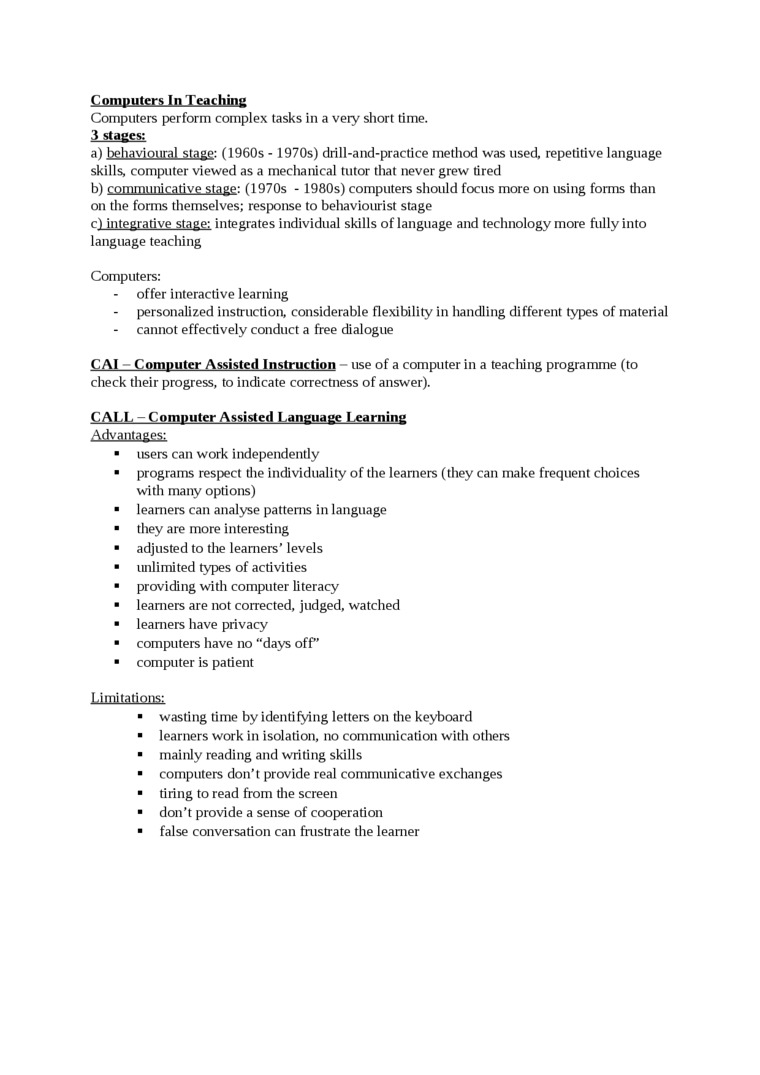86922

Computers In Teaching
Computers perform complex tasks in a very short limę.
3 staees:
a) behavioural stage: (1960s - 1970s) drill-and-practice metliod was used, repetitive language skills, Computer viewed as a mechanical tutor that never grew tired
b) communicatiye stage: (1970s - 1980s) computers should focus morę on using forms than on the forms themselves; response to behaviourist stage
ci integratiye stage: integrates individual skills of language and technology morę fully into language teaching
Computers:
- offer interactive learning
personalized instruction, considerable flexibility in handling different types of materiał
- cannot effectively conduct a free dialogue
CAI Computer Assisted Instruction - use of a Computer in a teacliing programme (to check their progress, to indicate correctness of answer).
C ALL - Computer Ąssisted Language.Learning
Advantages:
■ users can work independently
■ programs respect tlie individuality of the leamers (they can make frequent clioices willi many options)
■ leamers can analyse pattems in language
■ they are morę interesting
■ adjusted to the leamers’ levels
■ unlimited types of activities
■ providing with Computer literacy
■ leamers are not corrected, judged, watched
■ leamers have privacy
■ computers have no “days ofP’
■ Computer is patient
Limitations:
■ wasting time by identifying letters on tlie keyboard
■ learners work in isolation, no communication with others
■ mainly reading and writing skills
■ computers don't provide real communicatiye exchanges
■ tiring to read from tlie screen
■ don’t provide a sense of cooperation
■ false conversation can frustrate the leamer
Wyszukiwarka
Podobne podstrony:
tely and in a very short tims to cover the subjects which belong to a separate subject. Ws have in o
49839 Slajd23 (108) Przetwarzanie rozkazówRISC - reduce instruction set Computer CISC - complex inst
212 little was said of the individual social and professional groups which were described in a very
CREATION OF THE INDUSTRIAL PARK IN MYKOLAIY Short summary of the project Creation of the industria
teaching services performed by other units, i.e. bilateral provision of services by faculties, Sport
htdctmw 131 Here’s a different application of blacks. On the previous page we saw the black areas us
Aims are long-term goals, described in very generał terms: • practical aims - leam
55 (174) 5: Deep mycoses Figurę 5:9: Perinasal ulcer in a domestic short hair cal with cryptococcosi
123 SOMETHING WHICH HERODOTUS MAY HAYE SEEN generally uniformly attired. but, whereas the women, in
angielski7 eonie from the party whenever you want, you can meet with friends in a very good restaura
123 SOMETHING WHICH HERODOTUS MAY HAYE SEEN generally uniformly attired. but, whereas the women, in
agriculture Rei irwGround Beetles (Carabidae) in the Short-Rotation Coppice Willow and Poplar
33884 New Forms Taschen 193 In a very different style, the sculptural appearance of Josh Schweitzer
CSG265 254 Complete Spanish Grammar The Short Forms The short forms consist of a single word. The su
6001e970eaf26c787181f10620a71239 "A must-have resource lor audrtocs in today^s complex computin
więcej podobnych podstron